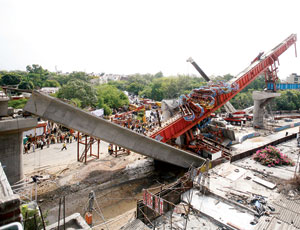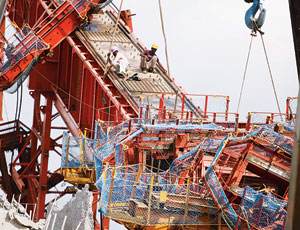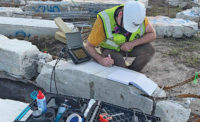A twofold collapse failure on a construction site for an extension of the Delhi Metro has officials investigating and rail opponents incensed. An elevated section of track came crashing down on July 12, killing six workers and injuring 20. One day later, three cranes trying to remove the launching girder had a “mechanical failure,” says Delhi Metro spokesman Anuj Dayal.
The design-build contract on the 20-km new corridor being built from Delhi’s central core to the southeast is held by Gammon India Ltd., a private firm contracted by Delhi Metro Rail Corp. Ltd.(DMRC). It established a four-member panel to investigate the tragedy and produce a report within 10 days. Much of the attention will be on the failure of the pier cap to balance the weight of the launching girder. “A committee is investigating...the cause,” Gammon India Vice President R.L. Telang told a news wire, adding, “There is no design fault.”
In a non-Delhi Metro-related incident, Gammon India also was held responsible for a construction scaffolding collapse in Hyderabad that claimed two lives in September 2007. It paid 10% of the project cost in that case.
The first Delhi accident took place on July 12 between two bridge piers, according to DMRC Managing Director Elattuvalapil Sreedharan. Five of 10 segments had been erected. “Pier 67 was taking the main load [of 25 tons] with the longest cantilever,” he says. “In this case, the cantilever was 4.2 m long.” The pier collapsed, and the launching girder came crashing down. Sreedharan says the collapsed cantilever was the longest to be used on any DMRC project. It was holding one launching girder as well as the girder to be erected, he added.
The next day’s cleanup operation fared little better. “When the lifting operation started, one of the high-capacity [250-tonne] cranes developed mechanical failure as its boom developed cracks and snapped,” says Dayal. The load then caused the boom of an adjoining 350-tonne crane to snap and another 250-tonner to topple.
Red-Faced
The accidents left authorities red-faced as resident groups stepped up their campaign against Delhi Metro lines running overhead. “Some 300 km of elevated Metro tracks on concrete pillars are hanging like the Sword of Damocles over our heads,” says Rajiv Kakaria, a Resident Welfare Association member.
Sreedharan, known as the “Metro Man,” submitted his resignation, claiming “moral responsibility.” However, the next day, he was convinced by the Delhi government to return to work. He had overseen the first 65-km phase of Metro construction, which was completed three years ahead of schedule in 2005 within a budget of $2.3 billion. The Delhi accident occurred during the 123-km second phase, expected to cost $4.5 billion. Among the planned 15 corridors is a high-speed airport link, scheduled to open when Delhi hosts the 2010 Commonwealth Games.
The 20-km section in which the accident occurred was slated to open by September 2010, a month before the Commonwealth Games. Metro officials do not believe schedule pressure is largely to blame for the increasing number of accidents.
This was the second major accident in the history of Delhi Metro. In October 2008, a launching girder collapsed while placing precast concrete girders, killing two in east Delhi. The contractor on that project, AFCONS, was blacklisted from further contracts.
Delhi Metro, which started operations in 2002, runs 70 trains and carries over 800,000 people daily.
















Post a comment to this article
Report Abusive Comment